Everything To Know About Babywearing
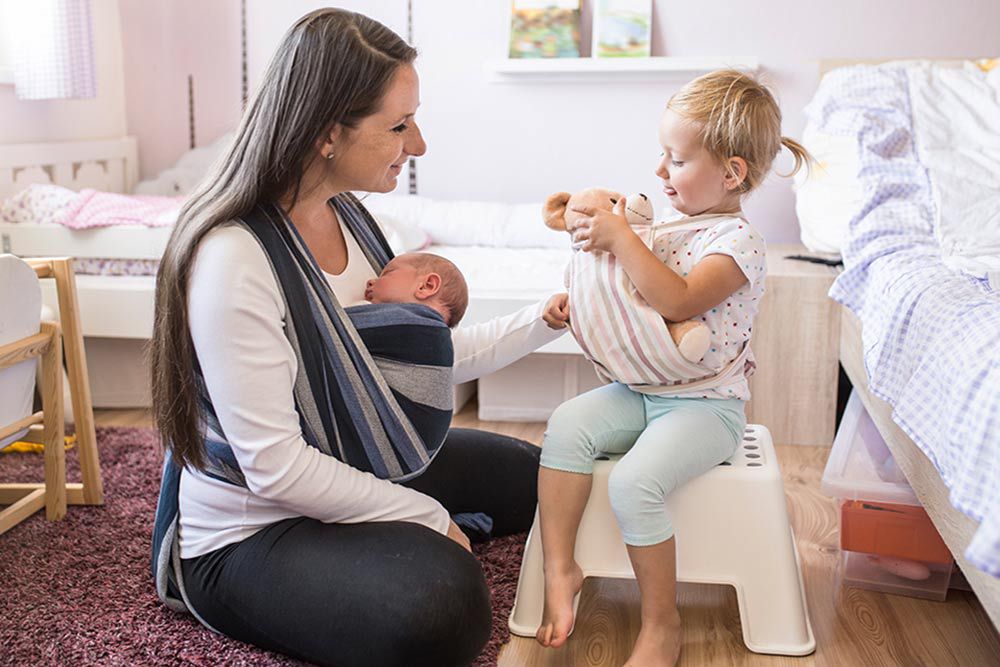
What it is, why it’s good for baby (and you!), safety tips, and more.
Expert Sources: Matthew Baral, ND; Charles Price, MD; William “Bill” Sears, MD; Nina Shapiro, MD; Amber Stevens
There is a unique joy that comes with cradling your baby in your arms or snuggling them up onto your chest as they drift into sleep to the soothing sound of your beating heart. It’s an experience unlike any other, and it’s an incredibly important piece to bonding with your baby.
But, as nice as it would be to spend all day—every day—cuddling your babe, real life has a way of demanding attention. Rather than put your baby down every time you have to get up to do the dishes, check your email, or fold the laundry (again), you can continue your skin-to-skin time, while also keeping your hands free, with babywearing.
What Is Babywearing?
Without any knowledge of what it is, “babywearing” sounds sort of ridiculous—after all, how can you wear a baby? In reality, “babywearing” is really just carrying your baby with the help of a specially designed product that will keep your little one close to your body while also freeing up your arms and hands for multitasking.
While the freedom to move about without having to put your baby down is a nice perk, studies show that babywearing helps infants create secure attachments to parents and caregivers, which is an important part of a child’s development. But that’s only the beginning of the list of benefits that come along with babywearing.
What Are the Benefits of Babywearing?
The mother’s intuition that urges you to pick up and hold your crying baby comes from a deep-seated place: Women have been wearing their children for the purposes of comfort and nurture for thousands of years. Because humans are “carrying species,” mothers before us brought their babies along with them as they walked through life, using everything from animal skin to plants to long pieces of cloth to keep them close. Our forebears knew that parents and babies belonged together, and here’s why.
Less crying
A randomized controlled study published in Pediatrics reported that babies who are worn cry an average of 43% less than babies who are not. Aside from being a bonus for your ears and nerves, William Sears, MD, (or “Dr. Bill”), a renowned pediatrician, author, and strong advocate for babywearing, says because these babies cry less often, they have a stronger bond with their caregiver.
“Parents of fussy babies [say] that once they started wearing their infants more, their babies seemed to forget to fuss, and because their babies fussed less, they were more fun to be with,” Dr. Sears told Pregnancy & Newborn.
One of the reasons he says this happens is because when a baby is worn, its ear is usually pressed up against the caregiver’s chest, allowing them to hear the comforting sound of a heartbeat. Additionally, Dr. Sears says a caregiver’s “rhythmic walk reminds baby of the womb experience,” which soothes them and reduces fussiness.
Easier bonding and increased confidence
According to Dr. Sears, bonding between a caregiver and a baby is also significantly easier when the baby is worn. In fact, when a parent tells him that they are struggling to bond with their infant, he “prescribes” three hours of babywearing a day to help improve the situation.
“Babywearing is important to promote the [birthing parent]-baby bond,” he explains, adding that it’s equally as important in establishing a bond between the non-birthing parent and the baby.
As an added perk, establishing a strong bond with your baby can also help you gain confidence as a new parent. The more time you spend in close contact with your baby through babywearing, the better you will be at reading their cues, which will help you anticipate their needs with greater success. Your faith in yourself as a highly competent baby-raiser will skyrocket, and both your baby and your fears will be calmed as a result.
Happier hand-offs
If your child is used to being worn, leaving him with grandma, grandpa or auntie will be a much simpler transaction if they also use a baby carrier (though, we can’t promise you it will be totally drama-free). Also, letting other family members in on the babywearing action helps them bond with baby as well, and learn the ins and outs of their newest and smallest kin.
Stronger sense of safety and improved development
“There isn’t a safer place in the world for baby to be than being carried literally right under the nose and eyes of a caregiver,” says Dr. Sears. Not only does babywearing allow you the ability to keep your babe physically safe, but as previously mentioned, it also helps establish a secure attachment between you and your infant. Matthew Baral, ND, a naturopathic pediatrician practicing in Phoenix, Arizona, says the secure attachment that’s formed through babywearing can then aid in a child’s development in a variety of ways.
“This strong security may encourage children to venture outside of their comfort zone, such as trying to take those first steps, which can be challenging and scary,” he says, “Babies who are carried around also show a faster development of motor skills—possibly because of the gravitational challenges that they are faced with when in a sling or worn in a baby carrier. They get exposed to all sorts of sensations that help them get used to the movement as an independent person who moves in different directions. The nervous system is very receptive to challenges and adapts accordingly.”
Healthy digestion
Another surprising benefit of babywearing is that it can have positive effects on an infant’s digestion, and in turn their overall health.
“Even babies who are born prematurely or are underweight gain weight faster and thrive better when carried,” explains Dr. Baral, “ It may be because these kids will feed more often due to the close proximity to their main food source. And when they do get food, they digest it better.”
He further suggests that the gentle motion and closeness to a caregiver that comes with babywearing promote improved movement of food through the intestines. Additionally, he says babywearing has been shown to decrease a baby’s risk for reflux.
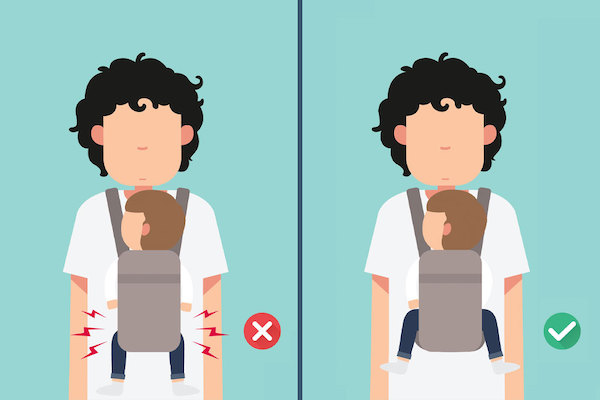
Babywearing Safety
The advantages of babywearing cannot be overstated, however, as wonderful as the practice is, it is essential to keep safety in mind. In a 2021 study, the American Academy of Pediatrics (AAP) found that babies aged 1 and younger who are worn are at an increased risk of serious injury or hospitalization than those who are not worn. Because of this, caregivers need to ensure they are well-educated in babywearing in general as well as in the specific product they use. Here are some other safety considerations parents should be aware of.
Caregiver stability
After reviewing 14,024 cases of babywearing-related injuries that occurred between 2011 and 2020, the AAP found that 22% were the result of a caregiver falling while wearing the baby. Of course, accidents can happen to anyone, even when all safety measures are in place, but it’s important to assess a situation before opting to wear your baby to determine if it’s a safe environment for you and, in turn, the baby. For example, consider whether or not you’ll be going up and down stairs or steep hills that can lead to falls, or if the ground might be slippery due to ice or rain.
Additionally, the AAP suggests caregivers “bend at the knees, not at the waist” when they are picking something up while babywearing, “otherwise the baby may tip out of the carrier and you may hurt your back.”
Hip placement
According to Charles Price, MD, a pediatric orthopedist and director of the International Hip Dysplasia Institute in Orlando, Florida, as many as 1 in 6 babies are born with loose joints and the hips can be particularly affected by this. While 90% of these babies go on to recover completely without any problem, some develop hip dysplasia. To avoid this, Dr. Price says caregivers should keep their baby’s hips in a natural position as much as possible during its first few months of life—which is important to remember when you’re wearing your baby.
“While there is no evidence for or against baby carriers as a cause of hip dysplasia, there is ample evidence that hip dysplasia is influenced by environmental factors including tight, traditional swaddling of the legs for long periods,” explains Dr. Price.
To ensure your baby’s hips are safely positioned, the International Hip Dysplasia Institute (IHDI) recommends that the baby’s legs be able to spread apart with the thighs supported and the hips bent.
Head positioning
In addition to how your baby’s hips are positioned when you’re wearing them, it’s incredibly important to pay close attention to how their head and neck are positioned—otherwise, your baby could suffocate.
“The most likely cause of [sudden infant death syndrome] SIDS, as well as the most likely cause of infant death in a carrier, has to do with head positioning during sleep,” explains Nina Shapiro, MD, Director of Pediatric Ear, Nose, and Throat at the Mattel Children’s Hospital UCLA and author of Take a Deep Breath: Clear the Air for the Health of Your Child. “If an infant’s head is positioned … against the material of a carrier, he can rebreathe his own carbon dioxide (the substance we breathe out).” When this happens, the baby can “become unconscious and can even stop breathing altogether.”
To avoid this, she says, first look at your little one’s neck position. “If their head is positioned so that their neck is fully flexed down, and is then compressed in a carrier, this may compress their throat and breathing passages, and block off their airway. It is safe to have your baby’s neck slightly flexed down, but not to the point where his chin is touching his chest.” Dr. Shapiro also notes that babies “rely on their noses, not their mouths, to breathe,” so caregivers should always make sure nothing is blocking their baby’s nose.
It doesn’t matter what kind of carrier you use, monitoring your baby’s head position is vital for safety, but if you’re using a sling, the AAP suggests it’s even more crucial because “some sling carriers may curl your baby’s body into a C-shape, which greatly increases the risk of breathing problems. If you use a sling, your baby’s neck should be straight and their chin not pressed into their chest, and make sure you can always see their face.”
Baby’s health and age
It should go without saying that you should always check a product’s size, weight, and age restrictions before using it with your infant. But even if your little one is technically within the “safe” range, it’s important to confirm with the pediatrician that babywearing is the best option for your child.
The AAP advises parents to consider their infant’s health and age to ensure safe babywearing. They say babies who are born prematurely or with respiratory problems should not be placed in “backpack [carriers] or other upright positioning devices” because these products can make it harder for them to breathe. For babies over 5 months old, they recommend caregivers ensure their child is properly positioned and strapped in before walking as at this age little ones “may become restless in the carrier … [and might] brace their feet against the carrier’s frame or your body, changing their weight distribution,” putting you both at risk of falling.
Carrier’s fit
Finally, the carrier you use needs to be the appropriate size and in good condition for you to safely wear your baby. The AAP suggests caregivers bring their little one with them when they go shopping for a carrier so that they can confirm it’s a good fit. “Make sure the carrier supports their back and the leg holes are small enough that they can’t possibly slip through.”
They also recommend checking out the carrier’s material to ensure it’s sturdy and in good condition. (This is especially important if you’re looking for something secondhand or using a hand-me-down from a friend.) You should continue to “check the carrier periodically for rips and tears in the seams and fasteners” as long as you are continuing to use it.
Different Types of Baby Carriers
To help you find the right carrier for you, Amber Stevens, former owner of Heavenly Hold Baby Carriers in Atlanta, Georgia, helps explain the different types of babywearing products.
First, consider your baby’s age and what positions you’re most interested in trying, and then ask your babywearing friends what they recommend. If you’re not sure where to start, here are the five most commonly used types of carriers on the market now.
Soft structured
The first type is probably the most popular and most similar to those that you can purchase at the “big box” type stores. Soft structured baby carriers are baby carriers that have just that—a padded, structured waist. Soft structured carriers are referred to as SSCs for short and are very versatile. You can wear small babies on the front (facing in), bigger babies and toddlers on the back and some even allow you to wear them as hip carriers as well.
These carriers are very popular because even heavy toddlers or preschoolers can be worn comfortably in the same carrier they were worn in as an infant. The soft structured waist on the carrier is what provides the optimal support to the babywearer. The padded waist does an excellent job of distributing the weight of the baby equally and off of your back to your hips and most powerful muscles—your quads! Also, soft-structured baby carriers typically have buckles, so there isn’t too much of a learning curve when learning to use them. Some have advanced or extra features that may take a bit to learn, but for the most part, they just buckle and go.
Try it: Ergobaby Embrace Newborn Carrier
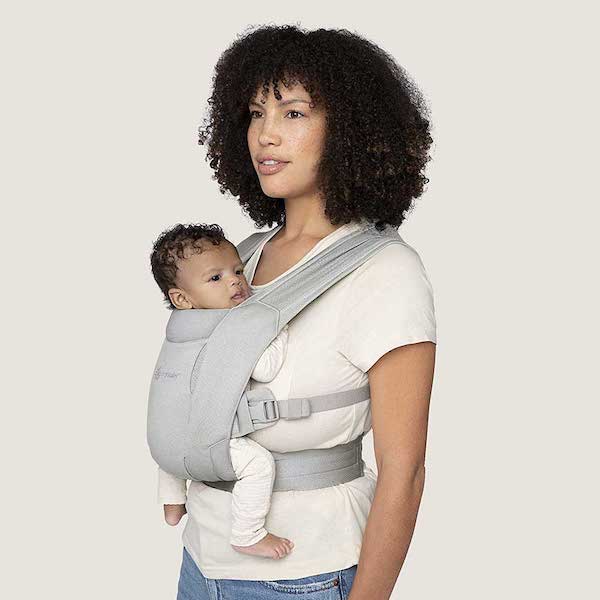
Mei Tai
The Mei Tai is a traditional Asian-style baby carrier that, instead of buckling like the SSC, ties to secure baby’s fit. It still can be worn on the front, back, or hip with newborns through toddlers, but it does have a bit of a learning curve because there are many different ways to tie the straps. An advantage to a Mei Tai is that it is usually very lightweight in construction and folds up nice and small!
Try it: Love & Carry Mei Tai Carrier
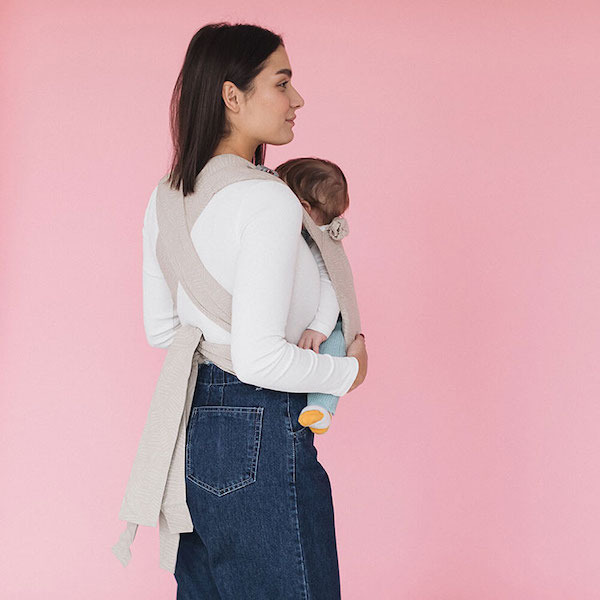
Wrap
A wrap is a long piece of fabric that you wrap around your body in various ways to hold your baby. A stretchy wrap is ideal for wearing a newborn and younger baby. It does a fantastic job of mimicking the womb by snuggling a baby down in the soft fabric. A stretchy wrap doesn’t work so well long-term because it is the nature of the fabric to be stretchy and not provide as much support for heavier babies.
A woven wrap, on the other hand, is made from tightly woven fabric. They can be hand-woven or machine-woven and are super supportive because they distribute the weight of the baby throughout your back instead of just one part of your back or shoulders. Woven wraps are more expensive than stretchy wraps, but they can be used for much longer.
Try it: Boba Wrap Baby Carrier
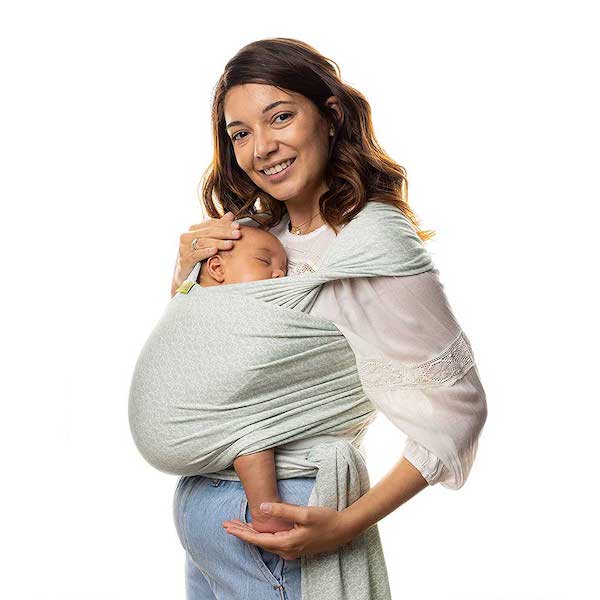
Pouch slings, ring slings
Finally, there are pouch slings and ring slings (sometimes called baby slings). Slings are carriers that are worn over one shoulder. Babies can typically be worn from infancy through toddlerhood in slings in five basic positions. A pouch sling is a carrier that is sized to only one babywearer. A ring sling is an adjustable sling that can be shared with another user. When wearing a baby in the sling, the lowest point of the sling should be either right at or a little above the babywearer’s belly button.
Try it: Nalakai Ring Sling Baby Carrier
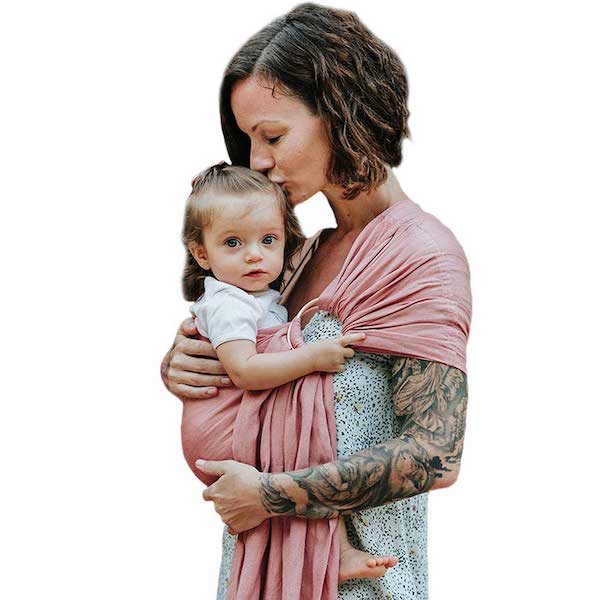
Babywearing comes with so many benefits, and with so many different styles, chances are good you’ll be able to find one that works for you and your babe. Just remember to prioritize safety—and to enjoy all the baby snuggles you can before they become too big to carry!








